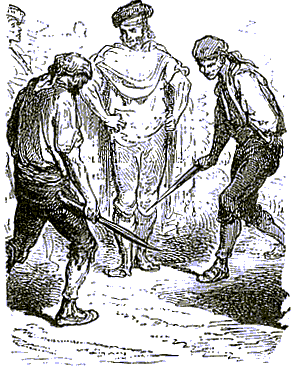
LESSON ELEVEN
TRETAS

We have arrived at the point in which with reason we will set ourselves apart from those who abhor the wielding of the navaja. Surely if we do not pay attention to other things than what results from the use of some tretas which certain tiradores put into practice, we should condemn their practice as immoral and ultimately ignoble; but our students have already seen the fundamental rules that we have given in the course of our lessons, and understand that not everything in the arte de tirar ß la navaja is vile and evil, and that on the contrary it should be considered subject to general principles like those of any other weapon. We do not desire to, through the relation of the various tretas dishonorable and cowardly men value highly, form a mindset equivalent to the tiradores of the navaja, when the abuse of them seperates those who do so from the art; those who work with the navaja study it in the same manner as a foil or a saber. Therefore we abstain from pointing out how repugnant this appears to our eyes, and the distance it is from the object that we propose to write this Manual; but at the same time it is not possible to go without speaking on some that we believe are adaptable in extreme cases, or which are convenient to prevent being attacked without cause.
We have said in the first part, that some tretas may be executed with the sash that the diestro should wear around the waist, and this is true. In the various corridas that the diestro makes in a fight, when the diestro wants to perform a treta with his sash, he has no more to do than loosen the end of it and let it drag on the ground, in a manner that his adversary easily steps on it, in which case quickly pull on it making him fall to the ground or slip dangerously.
Another treta may be executed with the sash, and it is; place in the end of it coins, rocks, or whichever thing that has sufficient weight, thrown violently by the diestro at the legs of his adversary, who will find them entangled and unable to move, will be in a position to be wounded.
The hat can be thrown at the face of the enemy, and it is a very effective treta.
Sometimes the diestro takes a handful of dirt, if there is any where the fight takes place, and throws it at the eyes of the adversary, and moves to atracar without delay.
The diestro can also step on one of enemy's feet, and it is a good treta if it isn't avoided.
The diestro can also give his enemy a strong kick in the stomach, or trip him with his legs, making him fall on the ground.
The diestro can turn his vision away from his adversary, and look behind him, who will believe that the diestro is looking at something behind his back, turn his head, and at that moment is atracado.
"Tente, que vas ß tropezar"* says the diestro to his enemy, with the object of making him look at the ground, and in the act be wounded.
Finaly, there are so many tretas employed by the tiradores, that it requires much time to explain all of them; and so we content ourselves with having given the most common and general.
"Tente, que vas ß tropezar"*: "Look out, you're going to trip!"